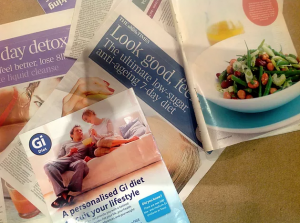Yes, a rather long title, but then the whole issue is rather like a shaggy dog story anyway…it takes ages to get to the point and so often the point is misinterpreted…so here goes.
This morning I read that geneticists have found that the number of changes in the number of copies of a gene called AMY1 are strongly correlated with obesity, even in twins who otherwise have the same diet and lifestyle. Just to explain to those who didn’t take much notice in their biology lessons, amylase is an enzyme which the body produces to break down carbohydrates so that the body can absorb the molecules of energy-giving carbohydrates into the blood stream and ultimately into our cells – energy being measured in calories, of course.
It appears that some people produce more amylase than others and therefore have a greater ability to absorb carbohydrates and consequently, potentially more calories. Yes…you can see where this is going…it means that it may explain why despite eating the same diet, some people seem to get fatter than others, as was proved in a recent controlled scientific trial. Indeed, this explains why even identical twins who grow up eating the same food, can be different shapes – one a slim-Jim and one who gains weight very easily….how unfair is that! But that’s nature, clearly…as has now been proved.
However, this isn’t the point I am trying to come to (I said it was a shaggy dog story)! My beef is not about the science per se, although it is always important to check who funded the research so that bias can be ruled out or indeed could sway the results and manipulate the information accordingly. No, my beef is that so often a bold headline can make an assertion…such as ‘Why obesity might be blamed on faulty genes’ or ‘Atkins gene’ reveals why obesity can run in family’ or ‘Obesity is in the genes’, Saturated fat ‘ISN’T bad for your heart’, ‘Your Fruits and Vegetables May Not Be as Healthy as You Think’. Now these are just a few examples and whilst I am not dissing what research has revealed, I do have a BIG issue with the message an attention grabbing headline affords.
We all do it – we take a quick glance at a headline and if, as is very often the case health reportage, see what we want to see! So my point is this…..in health stories the headlines can act as EXCUSES….you know….’I can’t help being fat because i’ve got faulty genes’, and therefore ‘I can be excused, or indeed, ‘do feel sorry for me if I eat doughnuts, fizzy drinks and processed junk food and then get fat – it’s my genes!’ Now in days gone by, when everyone cobbled together a meal of some description from fresh food on a daily basis and food manufacturers didn’t have the wherewithal to create ‘food’ (I use this term very loosely!), we didn’t need to look for excuses for being hugely overweight or obese because the fact was, that the majority of people were a healthy weight and were physically fit to boot.
I am going to end my shaggy dog story with a thought: Health reportage is necessary and informative, but if the overweight and obese folk can protect themselves behind the notions that some headlines present, then how useful is it ? Journalists should bear this in mind, particularly when on another page, in another newspaper, there is another story bemoaning the obesity and diabetes epidemic? Unbiased scientific trials are brilliant and necessary, but surely we should be looking at the bigger picture in terms of the messages that are being put out there and assessing how vulnerable they are to contextual misinterpretation……shaggy dog stories can be so confusing sometimes…..pass the doughnuts!




